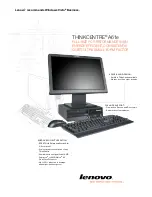
This section describes the types of tunnel-server ports that you can configure on
tunnel-server modules and the types of tunnel-service interfaces that you can run on
these ports.
Types of Tunnel-Server Ports
E Series routers support two types of tunnel-server ports:
dedicated
tunnel-server ports
and
shared
tunnel-server ports.
Dedicated Tunnel-Server Ports
Dedicated tunnel-server ports are virtual ports that are always present on dedicated
tunnel-server modules. These modules offer only tunnel services; they do not offer access
services.
Shared Tunnel-Server Ports
Shared tunnel-server ports are virtual ports that are always present on certain E Series
line modules that provide tunnel services in addition to regular access services. You can
configure the shared tunnel-server port to use a portion of the module’s bandwidth to
provide tunnel services.
Shared tunnel-server ports offer the following benefits:
•
Greater flexibility in deploying tunnel servers
You can use a shared tunnel-server module to provide tunnel services as an alternative
to using a dedicated tunnel-server module.
•
Cost savings
If you have limited tunnel-server processing needs, you can provide tunnel services on
a single available port of a shared tunnel-server module instead of having to allocate
the entire bandwidth of a dedicated tunnel-server module for this purpose.
Types of Tunnel-Service Interfaces
You can configure the following types of tunnel-service interfaces using dedicated
tunnel-server ports and shared tunnel-server ports:
•
Static IP interfaces that you configure and delete
Static IP interfaces include DVMRP and GRE tunnels. You must assign interfaces on
other line modules to act as source endpoints for these tunnels. For information about
configuring these tunnels, see
Configuring IP Tunnels
in
JunosE IP Services Configuration
Guide
.
•
Dynamic interfaces associated with an L2TP LNS session
The router establishes dynamic interfaces when required and removes the interfaces
when they are not required. For information about applications that use these dynamic
interfaces, see
L2TP Overview
in
JunosE Broadband Access Configuration Guide
.
•
Secure IP tunnels
IPSec-service modules are associated with secure IP tunnels. You must configure and
delete these interfaces statically; however, the router assigns tunnels to the interfaces
Copyright © 2010, Juniper Networks, Inc.
208
JunosE 11.2.x Physical Layer Configuration Guide
Содержание JUNOSE 11.2.X MULTICAST ROUTING
Страница 6: ...Copyright 2010 Juniper Networks Inc vi...
Страница 8: ...Copyright 2010 Juniper Networks Inc viii JunosE 11 2 x Physical Layer Configuration Guide...
Страница 16: ...Copyright 2010 Juniper Networks Inc xvi JunosE 11 2 x Physical Layer Configuration Guide...
Страница 24: ...Copyright 2010 Juniper Networks Inc 2 JunosE 11 2 x Physical Layer Configuration Guide...
Страница 66: ...Copyright 2010 Juniper Networks Inc 44 JunosE 11 2 x Physical Layer Configuration Guide...
Страница 228: ...Copyright 2010 Juniper Networks Inc 206 JunosE 11 2 x Physical Layer Configuration Guide...
Страница 247: ...PART 2 Index Index on page 227 225 Copyright 2010 Juniper Networks Inc...
Страница 248: ...Copyright 2010 Juniper Networks Inc 226 JunosE 11 2 x Physical Layer Configuration Guide...
















































